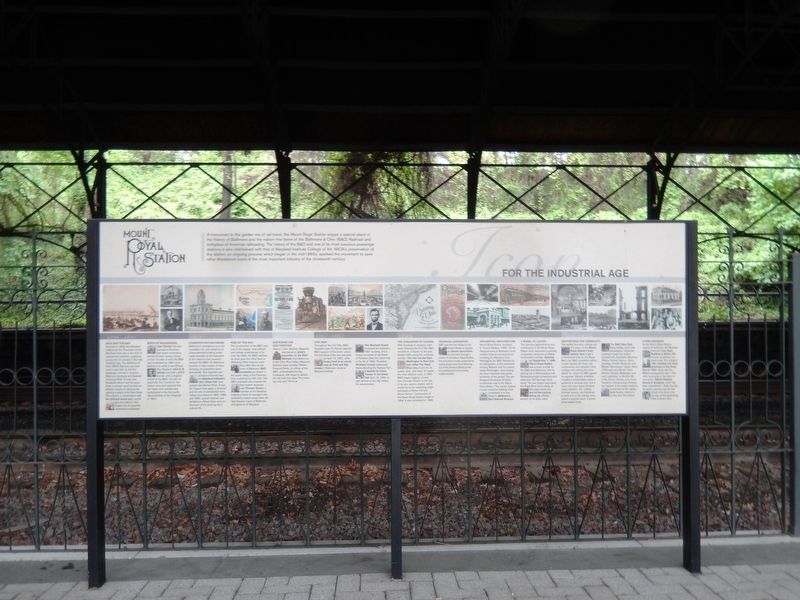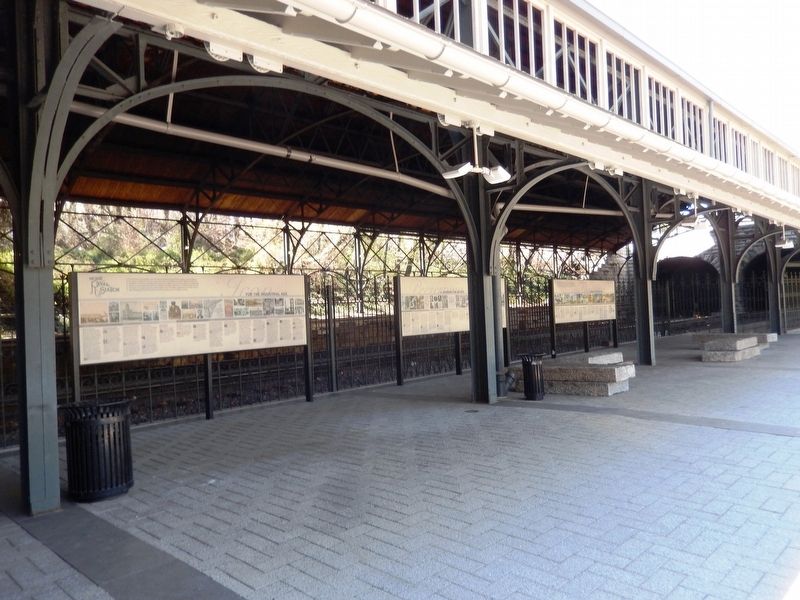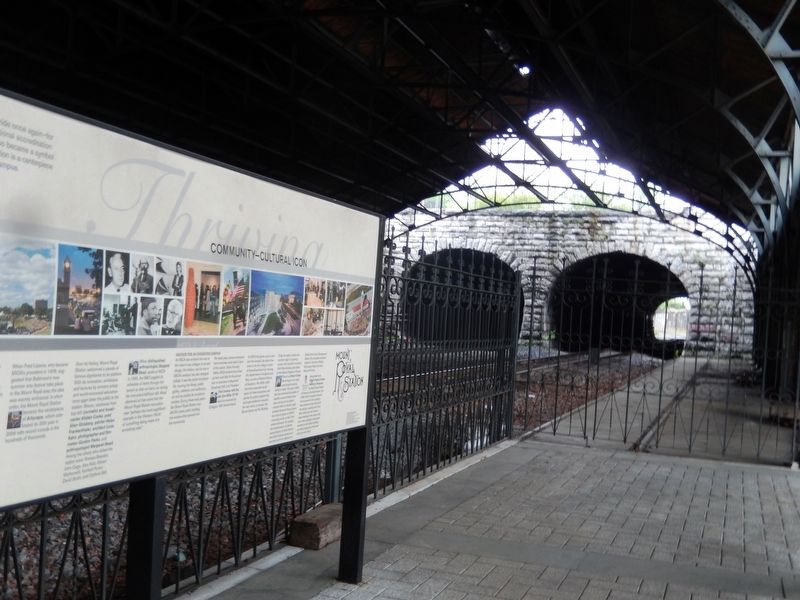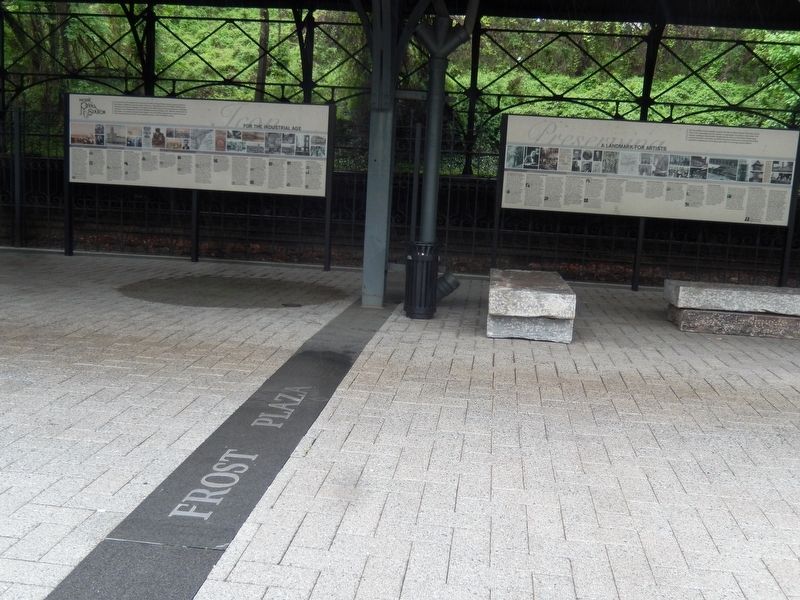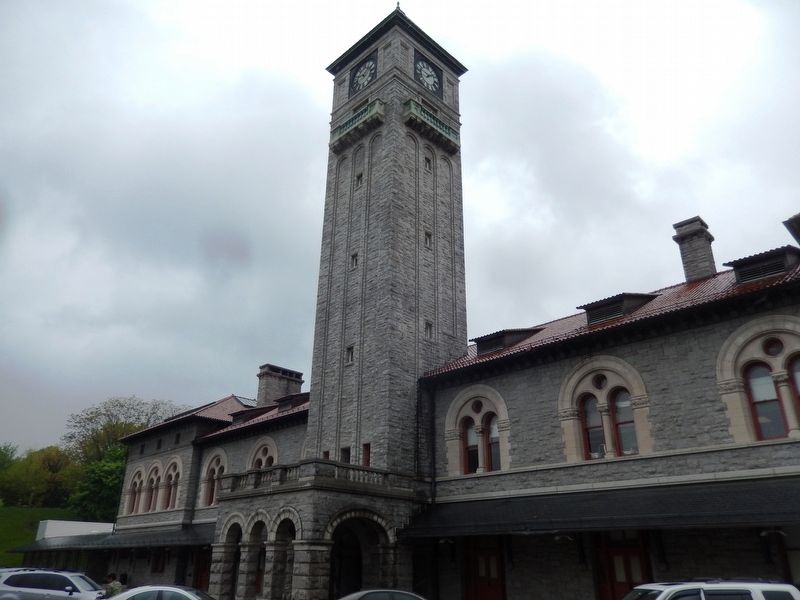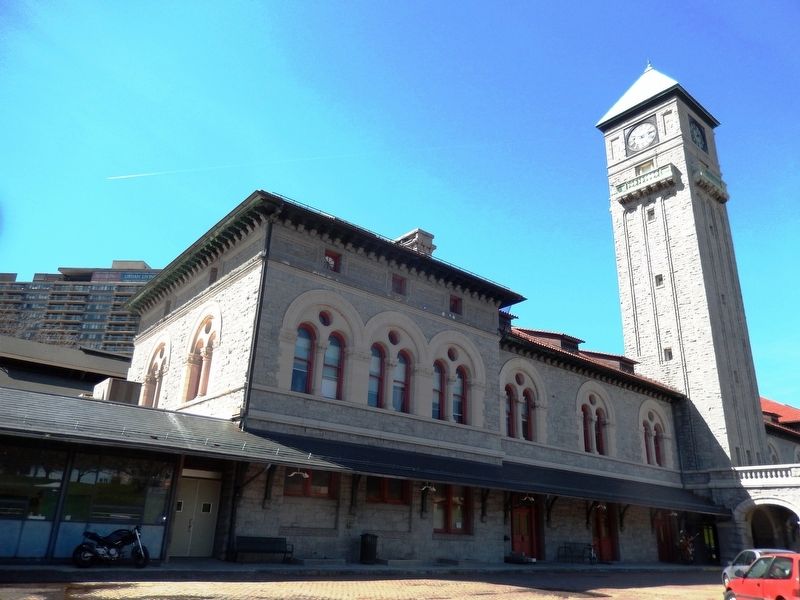Mid-Town Belvedere in Baltimore, Maryland — The American Northeast (Mid-Atlantic)
Mount Royal Station
Icon for the Industrial Age
A monument to the golden era of rail travel, the Mount Royal Station enjoys a special place in the history of Baltimore and the nation—the home of the Baltimore & Ohio (B&O) Railroad and birthplace of American railroading. The history of the B&O and one of its luxurious passenger stations is also intertwined with that of Maryland Institute College of Art. MICA’s preservation of the station, and ongoing process which began in the mid-1960’s, sparked the movement to save other threatened icons of the most important industry of the nineteenth century.
(Inscriptions under the images at the bottom)
1826-1827 MICA and the B&O-Founded in 1826
The Maryland Institute for the Promotion of the Mechanic Arts was a new kind of educational institution, preparing young men for careers in the new Industrial Age. The Baltimore & Ohio (B&O) Railroad was chartered a year later as the first passenger railroad in America. Baltimore merchants and bankers-including Philip Thomas and Alexander Brown and his sons-knew a railroad could provide an efficient means of reaching the growing markets of the New West. The railroad, in combination with the farthest inland port, would give the nation’s third largest city an important competitive advantage.
Birth of Railroading
“Tom Thumb,” the first successful American built steam locomotive, earned its fame racing a horse on the 13 miles of track the B&O had completed by 1830—from Baltimore to what is now Ellicott City. Maryland John H. B. Latrobe was both a MICA founder and a longtime official of the B&O. He was on board the Tom Thumb for this historic race and reported that the horse won. Latrobe also participated in the first public demonstration of the telegraph in 1844.
1851-Cosmopolitan Baltimore
Baltimore’s emergence as a cosmopolitan city was fueled by an unprecedented building boom made possible by the expansion of the nation’s most powerful railroad-the B&O. As Baltimore became a major center of manufacturing, its population grew dramatically. One important new structure of the era was the Maryland Institute’s 1851 Great Hall, near present-day Market Place. It was the “largest clear space in America” and the site of presidential nominating conventions in 1852, 1856, and 1860. Lyceum lectures and exhibitions offered there were at the heart of the growing city’s cultural life.
1859-Rise of the B&O
The construction of the B&O was one of the largest, most difficult, and riskiest undertakings of its time. By 1852, the B&O reached its initial goal-the Ohio River at Wheeling, West Virginia—more than 360 miles to the west of Baltimore. B&O surveyors are shown in the upper valley of the Potomac,
from a painting by H.D. Stitt. The B&O president who oversaw the first western expansion was Thomas Swann, a member of the Maryland Institute’s board of managers who endowed a lecture series there; he later became mayor of Baltimore and governor of Maryland.
1858-Sketching the New Frontier
Harper’s New Monthly Magazine sponsored an artist’s excursion on the B&O Railroad, from Baltimore to the Ohio River Valley. Maryland Institute board member William Prescott Smith, an officer of the B&O, orchestrated the trip. Outbound, with stops to sketch, the trip took four days. The return trip was only 16 hours.
1861-1865-Civil War
Throughout the Civil War, B&O President John W. Garrett assured B&O support of the Union cause. The first blood of the war was shed on April 19, 1861, when troops fired at an unruly mob at Pratt and Gay streets in Baltimore—close to Maryland Institute.
The Maryland Guard occupied the Institute’s 1851 building. Union troops wounded at the Battle of Antietam filled the Great Hall in the fall of 1862. President Abraham Lincoln addressed those attending the Sanitary Fair—a benefit for Union Troops –in the Great Hall April 18, 1864—a year (almost to the day) before his assassination.
1890s-The Challenge of Change
After focusing its energies westward, following the Civil War B&O decided to compete for the passenger traffic along the northeast corridor. The new service from Washington to New York was called the Royal Blue Line, known for its quality, style, and class. To create the most efficient route, in 1891, B&O began digging a tunnel from Camden Station to the site of its new uptown station, which would serve the expanding neighborhoods of Bolton Hill, and Mount Vernon. Construction of the Mount Royal Station began in 1894. It was completed in 1896.
Technical Information
B&O was the first railroad in the United States to operate an electric locomotive to pull trains through a tunnel. At the Mount Royal Station this prevented smoke produced by coal-burning trains from billowing out the Howard Street tunnel and polluting the surrounding neighborhoods.
Influential Architecture
Mount Royal Station architect, E. Francis Baldwin (1837-1916) designed some of Baltimore’s most notable Victorian-era structures, including the Maryland Club. Working for the B&O Railroad for the last quarter of the nineteenth century, Baldwin and his partner, Josias Pennington, were among the most important and prolific architects of the period. The pair designed the famous 22-sided roundhouse next to the Mount Clare Station. The world’s largest circular industrial building when completed, it is now home to Baltimore’s B&O Railroad Museum.
A Model of Luxury
The luxurious appointments and architecture of the Mount Royal Station were responses to growing competition along the profitable northeastern corridor. Opening on September 1, 1896, Mount Royal Station was a point of pride for the B&O and Baltimore, with its striking mix of Romanesque and Renaissance-style architecture and distinctive 150 foot-high clock tower. The new station epitomized the Royal Blue Line’s ideals of first-class travel—the turn-of-the-century dining car offered terrapin on its dollar menu.
Early 1900’s Centerpiece for Community
The vaulted two-story ceilings and rich décor of the Mount Royal Station’s main waiting room made it a memorable stop on the Royal Blue Line. B&O customers waited in style—mosaic tile floors, oak wainscoting, and stamped metal ceilings were among the many details for which the B&O spared no expense. Modern amenities included a private ladies’ parlor, a gentlemen’s smoking room, and a news and cigar stand. Rocking chairs (added in the 1920’s), Oriental carpets, and fireplaces at each end of the waiting room added a graceful touch. A gramophone played music.
The B&O Glee Club sang holiday carols with passengers. Dignitaries passing through the station included U.S. presidents Woodrow Wilson, Herbert Hoover, Calvin Coolidge, Franklin Roosevelt, and Dwight Eisenhower; Queen Marie of Romania and British Prime Minister Ramsay McDonald; and such celebrities as Buffalo Bill Cody, Enrico Caruso, and Arturo Toscanini—whose private Pullman car “parked” at the station while he conducted at the nearby Lyric theater, shown in a view from the station.
A New Neighbor
As the Mount Royal Station marked its tenth year, the Maryland Institute’s new Main Building in Bolton Hill neared completion one block north. The college’s 1851 building had been destroyed in the Great Fire of 1904-along with the B&O’s headquarters and 1,300 other structures in the heart of downtown. MICA’s Rinehart School of Sculpture, which had been established in 1896, the year the station opened, was the first school of its kind in the country. Its first graduating class is shown here.
Topics and series. This historical marker is listed in these topic lists: Arts, Letters, Music • Railroads & Streetcars. In addition, it is included in the Baltimore and Ohio Railroad (B&O), the Former U.S. Presidents: #28 Woodrow Wilson, the Former U.S. Presidents: #30 Calvin Coolidge, the Former U.S. Presidents: #31 Herbert Hoover, the Former U.S. Presidents: #32 Franklin D. Roosevelt, and the Former U.S. Presidents: #34 Dwight D. Eisenhower series lists.
Location. 39° 18.359′ N, 76° 37.199′ W. Marker is in Baltimore, Maryland. It is in Mid-Town Belvedere. Marker is on Cathedral Street. The marker is located on the right side of the station in Frost Plaza by the railroad tracks. Touch for map. Marker is at or near this postal address: 1400 Cathedral St, Baltimore MD 21201, United States of America. Touch for directions.
Other nearby markers. At least 8 other markers are within walking distance of this marker. A different marker also named Mount Royal Station (here, next to this marker); a different marker also named Mount Royal Station (here, next to this marker); Douglas L. Frost (a few steps from this marker); The Lyric Theatre (about 400 feet away, measured in a direct line); Rene Townsend (Chicago IL, 1952 - 1998) (about 400 feet away); The Maryland Line Monument (about 400 feet away); Anne Morris Owings (about 400 feet away); Lanvale Memorial Garden (about 600 feet away). Touch for a list and map of all markers in Baltimore.
Credits. This page was last revised on November 28, 2022. It was originally submitted on May 14, 2017, by Don Morfe of Baltimore, Maryland. This page has been viewed 376 times since then and 21 times this year. Last updated on October 21, 2022, by Carl Gordon Moore Jr. of North East, Maryland. Photos: 1, 2, 3, 4, 5, 6. submitted on May 14, 2017, by Don Morfe of Baltimore, Maryland. • Devry Becker Jones was the editor who published this page.
